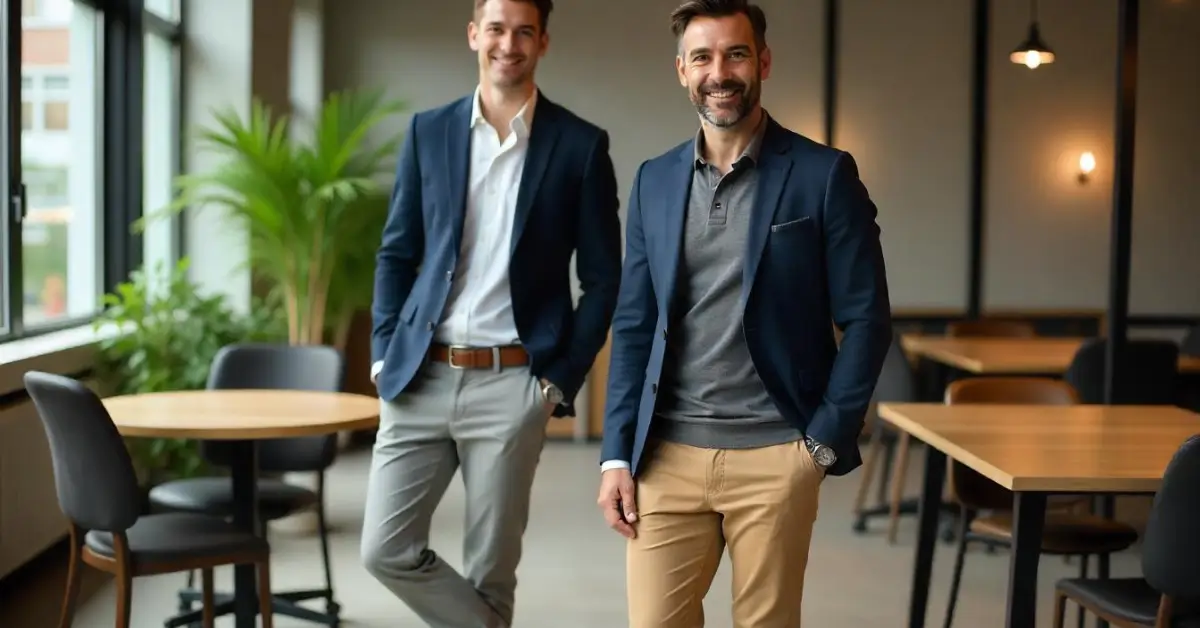FASHION
Business Casual Wear Men: The Ultimate Guide to Modern Workplace Style

As workplaces continue to evolve, so do dress codes. Gone are the days when every man had to wear a stiff suit and tie to the office. Today, the phrase “business casual wear men” has become a common—and often misunderstood—standard in modern professional environments. This comprehensive guide will walk you through everything you need to know about mastering business casual style for men, from its history to how to dress for success today.
Understanding Business Casual Wear for Men
Before diving into what to wear, it’s important to clarify what “business casual wear men” actually means. In simple terms, it blends elements of professional clothing with casual fashion, creating an outfit that is comfortable but still polished and appropriate for a professional setting.
Unlike formal attire, business casual allows for more flexibility. But it’s not a free pass to wear jeans and sneakers every day. It’s about striking a balance between smart and relaxed, looking confident without trying too hard.
Key Components of Business Casual Wear Men:
- Collared shirts (button-downs, polos)
- Chinos or dress pants
- Loafers, oxfords, or smart casual shoes
- Optional blazers or cardigans
- Well-fitted clothing that’s clean and wrinkle-free
The Evolution of Business Casual Style
The concept of business casual wear men has been around for decades. It first appeared in the 1960s when companies started offering “Casual Fridays” to boost employee morale. By the 1990s, tech startups in Silicon Valley rejected formal suits altogether, favoring a more relaxed but productive environment.
Today, business casual is the go-to dress code in many industries, especially in tech, marketing, design, and education. However, the interpretation still varies by location, industry, and even company culture.
Why Business Casual Works
Business casual wear for men is not just a trend—it’s a practical solution for the modern workplace. Here’s why:
- Comfort: Less restrictive fabrics and styles make it easier to stay comfortable throughout the day.
- Versatility: You can mix and match items, making it easier to transition from office to after-hours events.
- Personality: It allows room for personal expression while still keeping things professional.
Essential Pieces for a Business Casual Wardrobe
Let’s break down the staples every man should have for business casual wear:
Shirts
- Oxford button-down shirts
- Polo shirts (with structure)
- Lightweight sweaters or turtlenecks
- Neutral or subtle patterned colors
Pants
- Chinos (navy, khaki, olive, gray)
- Wool-blend trousers
- Slim-fit or straight-leg dark jeans (no rips or fading)
Jackets
- Unstructured blazers
- Sport coats
- Cardigans or knit blazers
Footwear
- Leather loafers
- Brogues or derbies
- Minimalist leather sneakers (if company culture allows)
Accessories
- Leather belt matching your shoes
- Simple wristwatch
- No loud jewelry or flashy items
Styling Tips for Business Casual Outfits
Here are a few expert styling tips to ensure your business casual wear men look hits the mark:
- Fit is king: Even the most expensive clothes look sloppy if they don’t fit well. Tailor your shirts and pants if needed.
- Keep it clean: Make sure clothes are ironed, shoes are polished, and your outfit is free of lint or wrinkles.
- Layer wisely: In cooler months, layering a crew-neck sweater over a button-down shirt adds both warmth and depth to your look.
- Don’t overdo it: Less is more. Stick to two or three complementary colors in an outfit.
Comparison Table: Business Casual vs Other Dress Codes
| Feature | Business Casual | Formal Business | Casual Wear | Smart Casual |
|---|---|---|---|---|
| Cost | Moderate | High | Low | Moderate |
| Comfort | High | Low | Very High | High |
| Ease of Use | Easy to Mix & Match | Requires Full Outfit | Very Flexible | Some Planning Needed |
| Workplace Fit | Most Modern Offices | Traditional Professions | Rarely Appropriate | Creative Industries |
| Formality Level | Medium | Very High | Low | Medium-High |
Business Casual Across Different Industries
Tech
Comfortable polos, chinos, and smart sneakers often make the cut.
Finance
A bit more formal; stick with button-downs, slacks, and leather shoes.
Creative Fields
More freedom with colors, prints, and relaxed styles.
Education
Practical and polished; cardigans, dark jeans, and oxford shoes work well.
Business Casual Do’s and Don’ts
Do:
- Wear clean, well-fitted clothes
- Invest in versatile, quality basics
- Keep a blazer handy for meetings
Don’t:
- Wear graphic t-shirts or hoodies
- Use worn-out sneakers or sandals
- Forget grooming and hygiene
How to Build a Business Casual Wardrobe on a Budget
You don’t need a full closet overhaul. Start with:
- 2 button-down shirts
- 2 pairs of chinos
- 1 pair of leather shoes
- 1 blazer
- 1 sweater or polo
Mix and match these to create multiple outfits that cover your weekly needs.
Seasonal Variations in Business Casual Wear
Spring/Summer
- Lightweight fabrics like linen
- Light-colored shirts and chinos
- Loafers or breathable shoes
Fall/Winter
- Wool-blend trousers
- Layered sweaters or knit jackets
- Leather boots or insulated dress shoes
Business Casual for Remote or Hybrid Work
Even on Zoom, your appearance matters. Keep a business casual shirt or polo handy for virtual meetings. Avoid looking too relaxed, especially if your camera is on.
Conclusion:
Business casual wear men is more than just a trend—it’s a new workplace standard that offers the perfect balance of comfort and professionalism. By understanding what to wear, where, and how to put it all together, you’ll make a lasting impression without ever needing a full suit. Stick to the basics, aim for clean lines, and always dress with intention. Whether you’re heading into a high-level meeting or working from home, your wardrobe should reflect your confidence and capability.
FAQ,s
What is business casual wear for men?
Business casual for men blends professional and relaxed styles. It typically includes collared shirts, chinos, and loafers, without the need for a full suit.
Can men wear jeans for business casual?
Yes, but only dark, non-distressed jeans in slim or straight-leg cuts. Avoid ripped or faded denim.
Is a polo shirt considered business casual?
Absolutely. A clean, structured polo shirt is a great option, especially in warmer weather or more relaxed office environments.

-

 TECH5 months ago
TECH5 months agoMATV Driver’s Video Augmentation Systems: Awareness in Modern Combat
-

 TECH5 months ago
TECH5 months agoAffiliated Industries: Driving Synergy Across Economic Sectors
-

 ENTERTAINMENT5 months ago
ENTERTAINMENT5 months agoUnblocked Games Bloons Tower: For Tower Defense Fans
-

 ENTERTAINMENT5 months ago
ENTERTAINMENT5 months agoflix.hd: Streaming Hub for Entertainment Enthusiasts
-

 BLOG5 months ago
BLOG5 months agoBill Pulte: Philanthropy, Innovation, and the Power of Twitter Giving
-

 TECH5 months ago
TECH5 months agoClickmate: Master Mobile Tap Automation
-

 BLOG5 months ago
BLOG5 months agoYado Yakub: Navigating Strategy, Policy, and Global Diplomacy
-

 TECH5 months ago
TECH5 months agoVobif: Unveiling the Power Behind This Innovative Solution